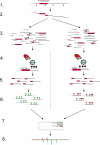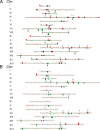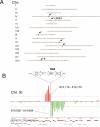Global mapping of transposon location
- PMID: 17173485
- PMCID: PMC1698948
- DOI: 10.1371/journal.pgen.0020212
Global mapping of transposon location
Abstract
Transposable genetic elements are ubiquitous, yet their presence or absence at any given position within a genome can vary between individual cells, tissues, or strains. Transposable elements have profound impacts on host genomes by altering gene expression, assisting in genomic rearrangements, causing insertional mutations, and serving as sources of phenotypic variation. Characterizing a genome's full complement of transposons requires whole genome sequencing, precluding simple studies of the impact of transposition on interindividual variation. Here, we describe a global mapping approach for identifying transposon locations in any genome, using a combination of transposon-specific DNA extraction and microarray-based comparative hybridization analysis. We use this approach to map the repertoire of endogenous transposons in different laboratory strains of Saccharomyces cerevisiae and demonstrate that transposons are a source of extensive genomic variation. We also apply this method to mapping bacterial transposon insertion sites in a yeast genomic library. This unique whole genome view of transposon location will facilitate our exploration of transposon dynamics, as well as defining bases for individual differences and adaptive potential.
Conflict of interest statement
Competing interests. Some reagents were the gift of Qiagen and others were the gift of Generation Biotech. One author (JD) is the founder of Generation Biotech and an inventor of haplotype-specific extraction (United States 2001–0031467 A1). Qiagen has licensed the commercial rights to haplotype-specific extraction products from Generation Biotech. AG, JD, and MJD have applied for a patent based on this work.
Figures






Similar articles
-
Transposon insertion site profiling chip (TIP-chip).Proc Natl Acad Sci U S A. 2006 Nov 21;103(47):17632-7. doi: 10.1073/pnas.0605450103. Epub 2006 Nov 13. Proc Natl Acad Sci U S A. 2006. PMID: 17101968 Free PMC article.
-
Identifying tagged transposon insertion sites in yeast by direct genomic sequencing.Yeast. 2000 Jul;16(10):967-70. doi: 10.1002/1097-0061(200007)16:10<967::AID-YEA597>3.0.CO;2-G. Yeast. 2000. PMID: 10870108
-
Insertional mutagenesis by a modified in vitro Ty1 transposition system.Gene. 1997 Oct 1;198(1-2):27-35. doi: 10.1016/s0378-1119(97)00288-6. Gene. 1997. PMID: 9370261
-
Jump around: transposons in and out of the laboratory.F1000Res. 2020 Feb 24;9:F1000 Faculty Rev-135. doi: 10.12688/f1000research.21018.1. eCollection 2020. F1000Res. 2020. PMID: 32148769 Free PMC article. Review.
-
Transposon-based strategies for microbial functional genomics and proteomics.Annu Rev Genet. 2003;37:3-29. doi: 10.1146/annurev.genet.37.110801.142807. Annu Rev Genet. 2003. PMID: 14616054 Review.
Cited by
-
Use of high throughput sequencing to observe genome dynamics at a single cell level.Proc Natl Acad Sci U S A. 2009 Dec 8;106(49):20830-5. doi: 10.1073/pnas.0906681106. Epub 2009 Nov 23. Proc Natl Acad Sci U S A. 2009. PMID: 19934054 Free PMC article.
-
SNP-specific extraction of haplotype-resolved targeted genomic regions.Nucleic Acids Res. 2008 Sep;36(15):e94. doi: 10.1093/nar/gkn345. Epub 2008 Jul 8. Nucleic Acids Res. 2008. PMID: 18611953 Free PMC article.
-
The soybean GmSNAP18 gene underlies two types of resistance to soybean cyst nematode.Nat Commun. 2017 Mar 27;8:14822. doi: 10.1038/ncomms14822. Nat Commun. 2017. PMID: 28345654 Free PMC article.
-
A hierarchical combination of factors shapes the genome-wide topography of yeast meiotic recombination initiation.Cell. 2011 Mar 4;144(5):719-31. doi: 10.1016/j.cell.2011.02.009. Cell. 2011. PMID: 21376234 Free PMC article.
-
New prediction model for probe specificity in an allele-specific extension reaction for haplotype-specific extraction (HSE) of Y chromosome mixtures.PLoS One. 2012;7(9):e45955. doi: 10.1371/journal.pone.0045955. Epub 2012 Sep 25. PLoS One. 2012. PMID: 23049901 Free PMC article.
References
-
- Kazazian HH., Jr Mobile elements and disease. Curr Opin Genet Dev. 1998;8:343–350. - PubMed
-
- Engels WR. P elements in Drosophila . Curr Top Microbiol Immunol. 1996;204:103–123. - PubMed
-
- Kim JM, Vanguri S, Boeke JD, Gabriel A, Voytas DF. Transposable elements and genome organization: A comprehensive survey of retrotransposons revealed by the Saccharomyces cerevisiae genome sequence. Genome Res. 1998;8:464–478. - PubMed
-
- Bennetzen JL. Transposable element contributions to plant gene and genome evolution. Plant Mol Biol. 2000;42:251–269. - PubMed
-
- Bushman FD. Targeting survival: Integration site selection by retroviruses and LTR-retrotransposons. Cell. 2003;115:135–138. - PubMed
Publication types
MeSH terms
Substances
Associated data
- Actions
Grants and funding
LinkOut - more resources
Full Text Sources
Other Literature Sources
Molecular Biology Databases

